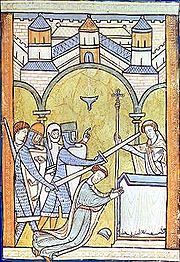
Reginald Fitzurse
Encyclopedia

Knight
A knight was a member of a class of lower nobility in the High Middle Ages.By the Late Middle Ages, the rank had become associated with the ideals of chivalry, a code of conduct for the perfect courtly Christian warrior....
s who murdered Thomas Becket
Thomas Becket
Thomas Becket was Archbishop of Canterbury from 1162 until his murder in 1170. He is venerated as a saint and martyr by both the Roman Catholic Church and the Anglican Communion...
in 1170.
His name is derived from Fitz which is a contracted form of the Norman-French fils de, meaning "son of" and Urse from the Latin ursus, meaning a bear, probable nom de guerre of his ancestor. Although he lived before the true age of heraldry
Heraldry
Heraldry is the profession, study, or art of creating, granting, and blazoning arms and ruling on questions of rank or protocol, as exercised by an officer of arms. Heraldry comes from Anglo-Norman herald, from the Germanic compound harja-waldaz, "army commander"...
which developed in the early 13th.c., his shield bore the cognizance of a bear.
Fitzurse was the eldest son of Richard FitzUrse, on whose death about 1168 he inherited the manor of Williton
Williton
Williton is a medium-sized village and civil parish in West Somerset, England. It has many of the facilities of a small town, being the administrative centre for the district. Williton is situated at the junction of the A39, A358 and B3191 roads...
, Somersetshire. He also held land in Leicestershire and Northamptonshire and at Barham, Kent
Barham, Kent
Barham is a village and civil parish in the City of Canterbury district of Kent, England. It is situated close to the A2 road between Canterbury and Dover, 7 miles south-east of Canterbury and 7 miles north of Folkestone....
, between Canterbury
Canterbury
Canterbury is a historic English cathedral city, which lies at the heart of the City of Canterbury, a district of Kent in South East England. It lies on the River Stour....
and Dover
Dover
Dover is a town and major ferry port in the home county of Kent, in South East England. It faces France across the narrowest part of the English Channel, and lies south-east of Canterbury; east of Kent's administrative capital Maidstone; and north-east along the coastline from Dungeness and Hastings...
. He lived for a time at Barham Court
Barham Court
Barham Court is a fine old house in the village of Teston, Kent.It was once the home of Reginald Fitz Urse, one of the knights who murdered Thomas Beckett in Canterbury Cathedral in 1170....
in Teston
Teston
Teston is a village in the Maidstone District of Kent, England. It is located on the A26 road out of Maidstone, four miles from the town centre. There is a narrow stone bridge over the River Medway here....
. The name of the village of Barham is derived from Bear (Urse in FitzUrse) and Ham because it was a hamlet. He was a Knight Attendant upon Henry II.
At Christmas, 1170 he was at the court of Henry II at Bures in France when Henry ranted against Thomas Becket. He and the other three knights, Sir Hugh de Moreville
Hugh de Morville, Lord of Westmorland
Sir Hugh de Morville was an Anglo-Norman knight who served King Henry II of England in the late 12th century. He is chiefly famous as one of the assassins of Thomas Becket, Archbishop of Canterbury in 1170...
, Sir William de Tracy
William de Tracy
Sir William de Tracy, Knt., was Lord of the Manor of Toddington, Gloucestershire, feudal Baron of Bradninch, near Exeter, and Lord of Moretonhampstead, Devon...
and Sir Richard le Breton
Richard le Breton
Sir Richard le Breton was one of the four knights who murdered Saint Thomas Becket.He was the son of Simon le Bret or Simon Brito of Sampford Brett in Somerset and a near neighbour of the FitzUrses of Williton...
or Brito crossed the Channel and met up in Saltwood Castle
Saltwood Castle
Saltwood Castle is a castle in Saltwood village—which derives its name from the castle—1 mile north of Hythe, Kent, England.The castle is known as the site where the plot was hatched to assassinate Thomas Becket...
, Kent to plan their attack. On Dec 29 1170 they burst into the cathedral choir at Canterbury clad in armour and carrying swords determined to capture or kill Becket. FitzUrse appeared to be their ringleader and delivered the first but non-fatal blow to Becket's head and the other knights followed suit until Becket lay dead. Christendom was outraged and the King filled with remorse. The four knights initially escaped to Scotland and thence to Knaresborough castle. All four were excommunicated by the Pope on Easter Day and ordered to make a penitential pilgrimage to the Holy Land. It is believed that none returned.
Legends hold that Fitzurse fled to Ireland where he fathered the McMahon
McMahon
McMahon or MacMahon is an Irish surname.- Two Septs:Two septs arose in Ireland with the surname McMahon, one in the Kingdom of Oriel in the province of Ulster, around modern County Monaghan; the second in Thomond, in the province of Munster, in modern County Clare.The sept in County Clare descends...
clan.

